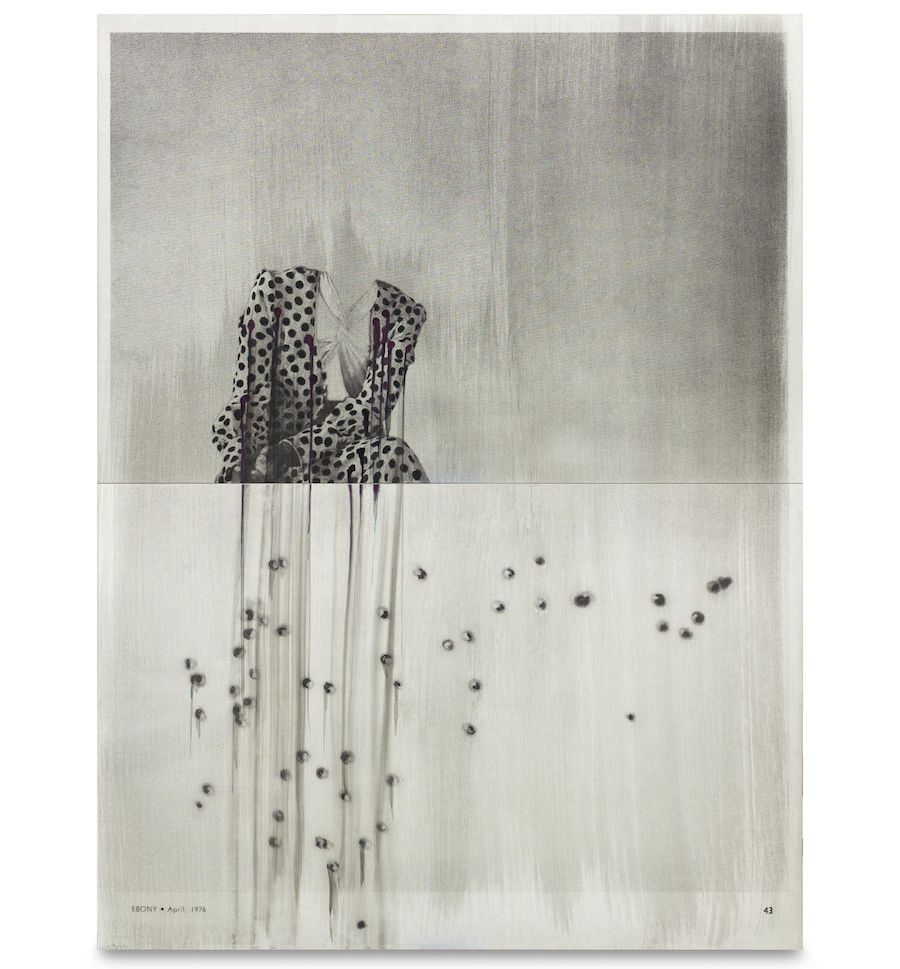In 2016, it’s not unusual to open a newspaper and fall into an uneasy trance reading the horrors that have transpired around the world. A grim headline conveying an all too familiar injustice, an accompanying image that’s evocative or exploitative or both. Facts fade into the background as a single, haunting particular ― a garment of clothing, a final plea for life, a bag of candy ― becomes more in itself than a single brain can digest.
The experience of looking at artist Lorna Simpson’s most recent multimedia series, made from India ink and screen print on claybord, echoes the experience of encountering current events in print. Found images are deconstructed and fragmented to isolate a single detail ― a polka-dotted dress or a pair of clasped hands ― their symbolism ambiguous and significance palpable. Text is scrapped in favor of haunting washes of black ink, impeding like a dark, clawing shadow.
In Simpson’s “Polka Dot & Bullet Holes #2, 2016,” a bifurcated image juxtaposes a woman’s polka-dot dress with a constellation of bullet holes. The circular fissures serve as bleak foils to the stylish garment, the stark contrast of expressing one’s identity and losing it, swiftly and utterly. The austerity of the print only makes it more unnerving; the discomfort of knowing something is a symbol without knowing what it symbolizes. It’s the eeriness of a dress spotted on the side of the road, its wearer nowhere to be seen.
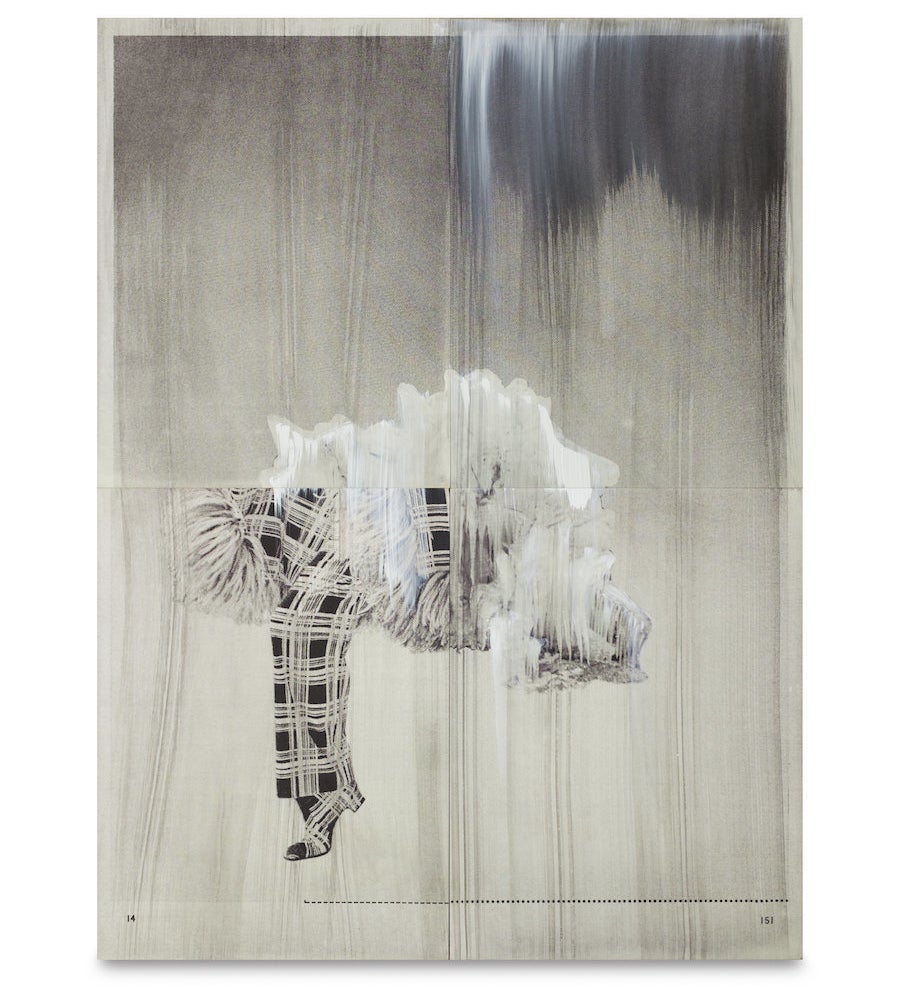
Simpson, who was born in Brooklyn and works there today, has employed a variety of media including photography, video, collage and painting to explore the relationship between image and identity, especially as it relates to race and gender. One of her most iconic photography series, 1989’s “Necklines,” depicts tightly cropped photos of black women’s necks, punctuated by a white collar. The images are reminiscent of elegant perfume ads, disembodied and cut short. Beneath the images, words like “neckline,” “necking,” “necklace” and “breakneck” suggest beauty, love and violence simultaneously.
For her most recent exhibition at Salon 94, Simpson excerpts images from old issues of Ebony and Jet magazines, along with Associated Press photos from the 1930s to 1970s, to confront contemporary issues of racism and police brutality. The fragmented ads and news clippings become, through Simpson’s hand, incorporeal symbols, addressing pain and exasperation that is as relevant today as it was in the ‘60s. Amplifying the screen-printed photos with ink and paint, Simpson conjures the excruciating numbness that results from an endless onslaught of gross injustice.
Simpson’s serialized, monochromatic works read like pages in a newspaper that stretch throughout time and space, grouping together the stories that by now are as familiar as folklore. We reached out to Simpson to learn more about her life and work.
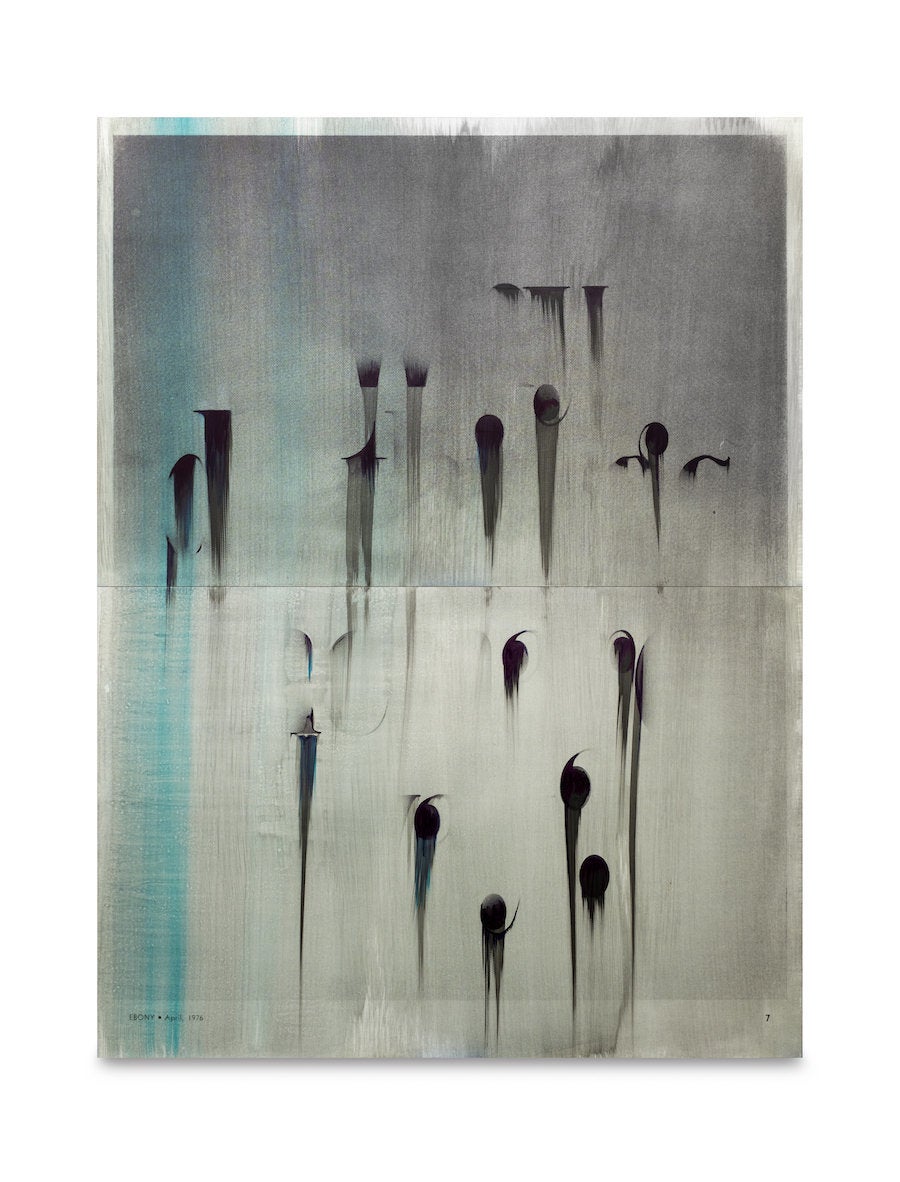
As a kid growing up in New York, what influence did museums and galleries have on you?
Growing up in New York with parents who weren’t New Yorkers, I was brought to plays and museums constantly. I wasn’t as much influenced by visual artists at that time, as much as theater. Although certainly way over my head, the experience of theater brought language and literature to life, which I found amazing.
I was also personally involved in dance as a child. I did ballet with the Bernice Johnson Cultural Arts Center, a dance school in Jamaica, Queens. We had our recital at Lincoln Center. As a young, black child, to perform on that stage was really amazing. I felt ownership over it. Because so much art and performance was part of my early education, I felt very at home in certain institutions, like New York was also my city. Today, it’s rare for a child growing up in a public school environment to feel that sense of ownership in relation to different New York institutions.
Did you make visual art growing up?
I was really interested in photography. I remember being really sick with the flu one winter and going through so many Kleenex tissue boxes when I realized that on the backs there were these coupons. If you sent in a bunch you could get a Polaroid camera. My parents also gave me a hand-me-down camera. I remember taking pictures of my dog and of my neighborhood. That’s where I started.
At what point did you realize art was more than a hobby, but a career?
Well, I went to the the High School of Art and Design for high school. And because of all my experiences in the arts, in some way, I kind of chose my course because I couldn’t imagine doing anything else but.

Were you worried, practically, about “making it” as an artist?
At that time, I had expertise in graphic design so I wasn’t really worried about getting a job. There was a point while I was in college at the School of Visual Arts when my dad, who was paying my tuition, said he wanted me to take more educational certification classes, to pursue being a teacher. I didn’t want to do that so I ended up taking out student loans and paying for my college education myself.
I went with my gut pursuing what I wanted to do. In terms of the art market, I didn’t foresee the success that would happen. Going into college I had a residency at the Studio Museum in Harlem where I met Kellie Jones, who was a very young curator at the time, working towards a PhD in art history, and David Hammons, who was an artist in residence at the time.
I was really young and wanted a broad network. But I never really equated the success of other people with anything to do with me. It was just amazing to be a fly on the wall and watch other people work.
You mentioned Kellie Jones. Can you talk a little bit about your relationship ― how it shifted over time?
When I met Kellie, I think she was a curatorial intern at the Studio Museum at the time. One day we went out to lunch in Morningside Park and got to know each other. She was into art. I was an artist. It was one of my first experiences meeting a young black woman and being able to talk about art history in an expansive way in an institutional setting that included us. I had taken a bunch of classes at SVA and was somewhat well-versed.
It was about creating this milieu of people I could talk to about what I was interested in. That was really important to me. Community. People that had interests that would amplify my own, and inform them in different kinds of ways. Kellie was one of the first people to do that. I feel like, as a younger artist, I was not so much ambitious about having a career, but about really having an interesting experience and being within certain artistic communities I thought were important. Trying to find a way in, even through being a fly on the wall.
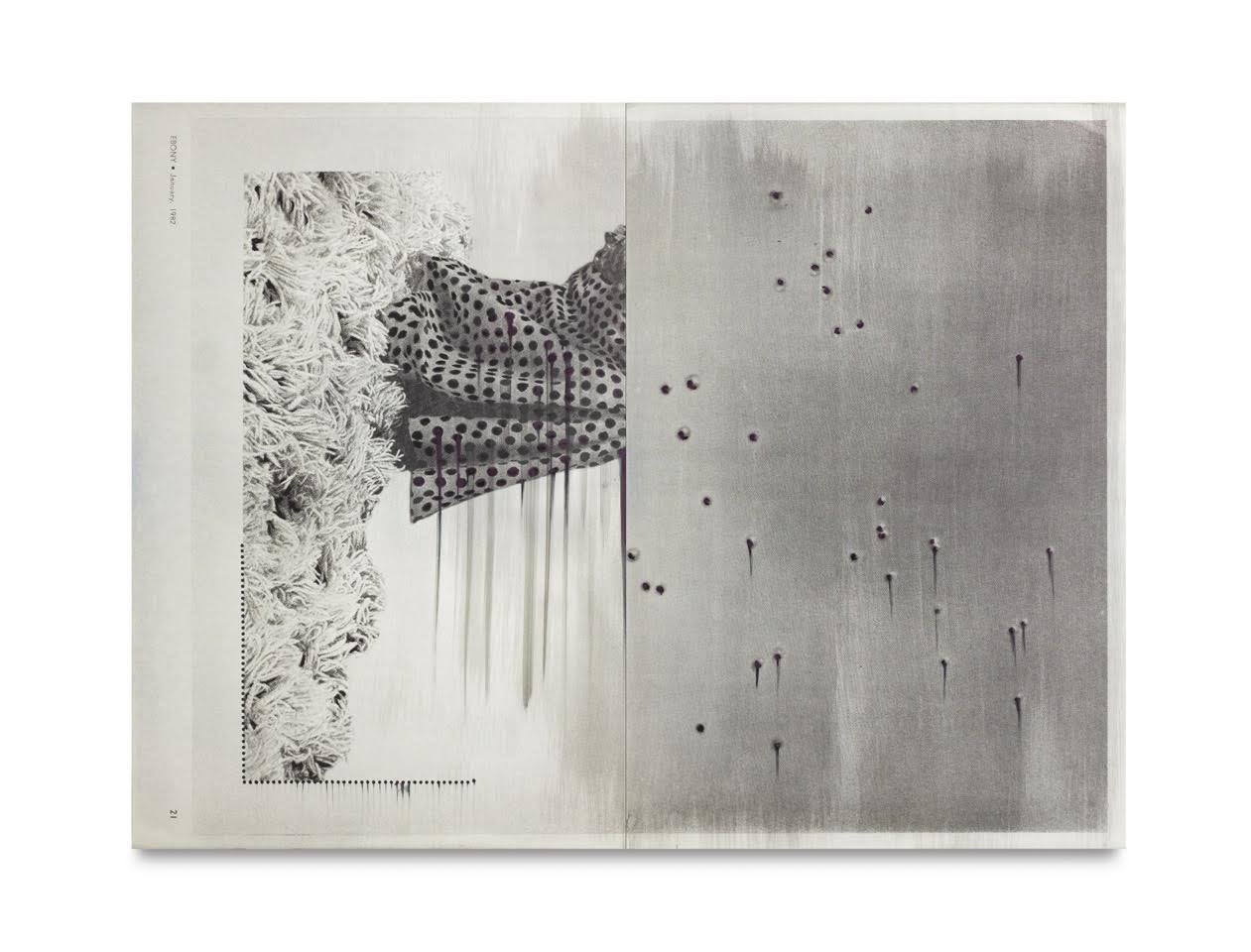
Ebony and Jet magazines are collaged and repurposed in your upcoming Salon 94 exhibition, and have factored into your past work as well. What roles have these publications played in your life?
My grandmother and mother are from Chicago, and that certainly is the mecca for Johnson Publishing Company. At my grandparents’ house, they got Ebony and Jet on a weekly basis. Many years later I came across this box of magazines, a lot of them from the mid ‘60s, that mentioned the death of Martin Luther King Jr. and all these significant issues from the civil rights era.
It struck me that the magazine understood its audience as being African-American. Even just going through the advertisements for beauty products, cigarettes, and liquor ads. There is something about them that focuses the ads to a black audience. I started collecting them and now have a mini archive. There are also ties to the way we live now. In the ‘60s and early ‘70s, the political issues that were at hand are still in play now in a very obvious way.
In your Salon 94 show, the magazine fragments take on an almost ghostly presence, a stark departure from your earlier, more celebratory series on black beauty. Can you talk about the space you mentally occupied when creating these more recent works, and their relation to what’s going on in the world?
I think, for me, this show is a little different in the way I entered into the subject matter. Some of it is a result of the barrage of deaths by police brutality over the past few years, which we can see and experience almost in real time through Facebook or Instagram. That, to me, has been unnerving and unrelenting in a way. That does seep into the work. The piece “Polka Dots & Bullet Holes,” for example, features a dress that has polka dots, aligned with these arbitrary dots that are bullet holes. They are all bleeding or dripping with ink.
Also, I found it to be an emotional time for me in terms of my personal life. The work has this personal unrelenting drama and, at the same time, that is reflected in the larger scope of what is going on in America at this moment.
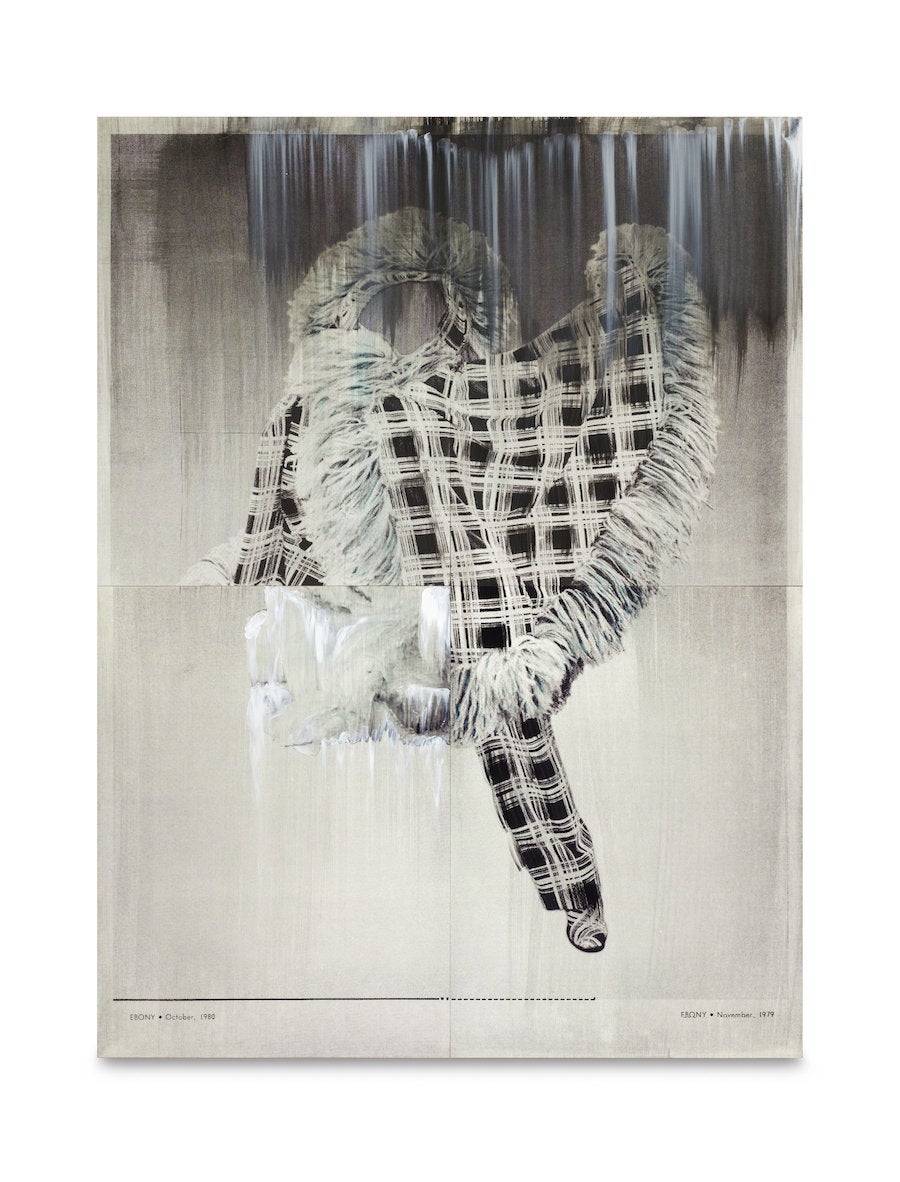
You’ve spoken about the “free-form, spontaneous quality” of applying ink to canvas, as opposed to the more methodical process of selecting, cutting, and pasting images. When you’re working, do you feel as if you’re inhabiting distinct speeds and spaces depending on the medium you’re working with, or does it all flow together?
Even with the collages, which combine AP photos with different things from Ebony and Jet, everything is kind of thrown together instinctually. I try not to overthink so much, to make these combinations of things quickly and instinctually. I work in so many different mediums, I like being in this particular period of jumping back and forth. There’s a lot of shifting back and forth as the thing is being made. In this period I’ve had more time as an artist in the studio to work and play.
Is it possible to describe how you know when a work is finished?
I have certain deadlines, so my studio manager is keeping things on schedule. There was actually a moment recently when one of my paintings got completely wrapped up and it wasn’t done. We had to take it out again.
But really, it’s done when it’s done. It’s unexplainable. That’s been nice. So much of the other work I’ve done is conceptually tight, but now that it’s involving my hand and gestures, it prolongs the finished thing. I can’t define the line between finished and unfinished until I just say that it is. It is so physical. Who knew painting was so physical? I didn’t consider that until I really started to get into it. I know it intellectually, but in terms of process, now I really understand how that plays out.
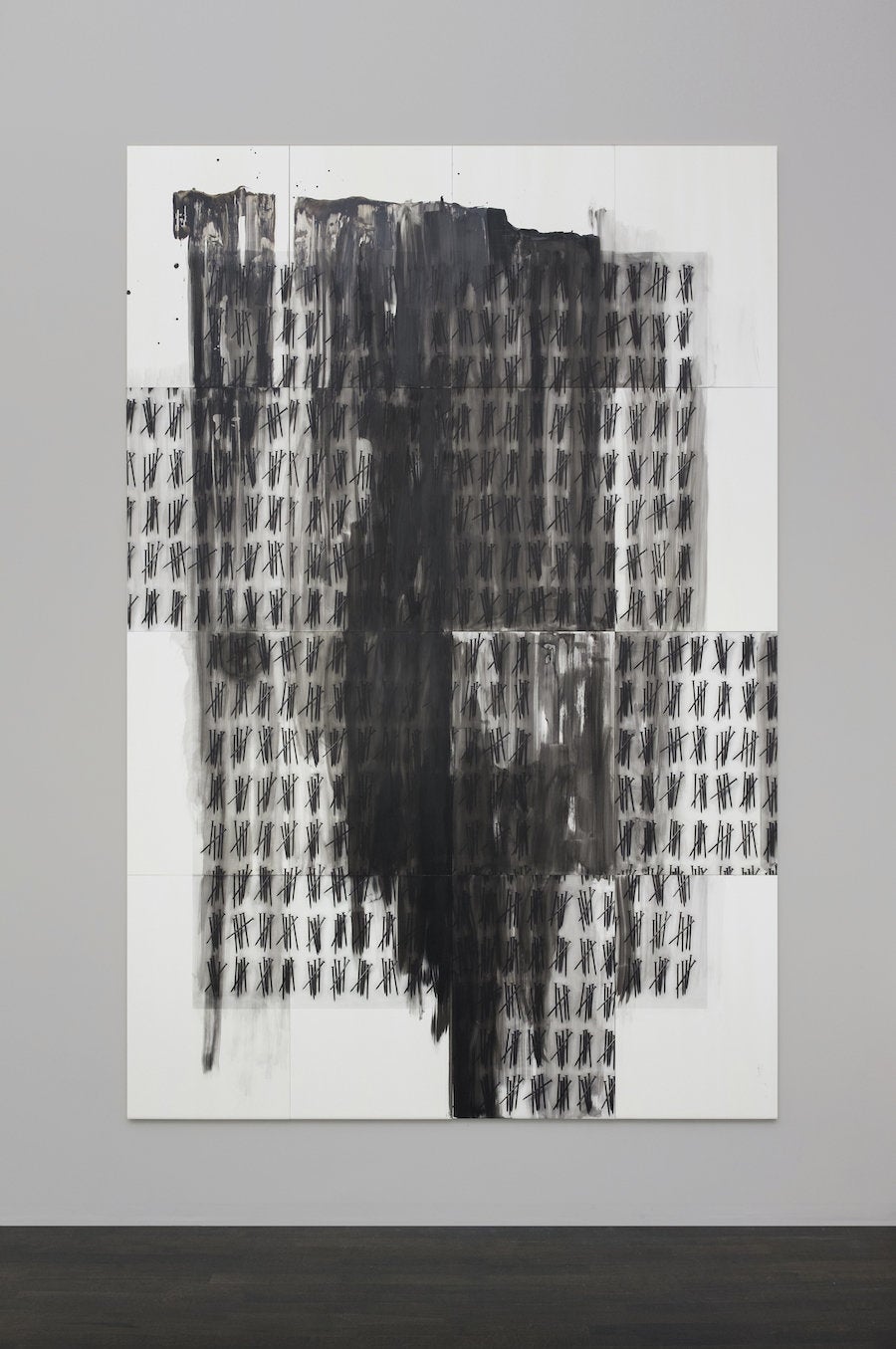
Your piece “Enumerated,” at 12 feet tall and 9 feet wide, is arguably the focal point of the exhibition. It’s such a simple yet searing image, can you talk about how this piece came to be?
It’s a detail from an advertisement I saw that was counting these nails. The first thing that came to my mind whenever I see that way of counting to five ― those four lines with a line through them ― is always a prisoner carving marks into a wall. Probably from film, or maybe Albert Camus.
Counting ― whether counting time or incidents ― that’s something we do unconsciously. When something happens over and over, or we’re waiting for something to end. When I think of Black Lives Matter and the platform they have given to families that have experienced police brutality, the mothers and sisters and wives, there is always this waiting that occurs in terms of: Will these officers be prosecuted? All those things — waiting and time and outcome, the repetition of that, is something that I feel.
The piece is conceived of as a series of five panels. As you approach it, you really don’t see that they are nails, but they just look like these strikes. The unrelenting enormity of the number and counting. I’m not trying to direct the viewer to a specific political event, but more of a conceptual space. Living in the time that we’re living in, the viewer will come to some of their own conclusions as to how they might read the work. It’s not imperative that someone understands everything that I’m saying right now.
You’ve mentioned in other interviews that you often meditate before beginning a day in your studio. How has this routine influenced your practice, if at all?
I think it’s really to keep my sanity. For some people, mediating or yoga is this thing of calming. For me, meditating can be upsetting. I can be weeping. But it brings me to how I am feeling now. Rather than trying to avoid it or readjust, it makes me confront it. However I am in that moment, in that emotional state, I accept it. I can feel vulnerable or sad and distraught and still work. Part of the practice of working is accepting that there will be a range of emotions and states that come in, not just a good happy state in which to work. I can say to myself, ‘I don’t feel great today. Okay, let’s go in with that.”
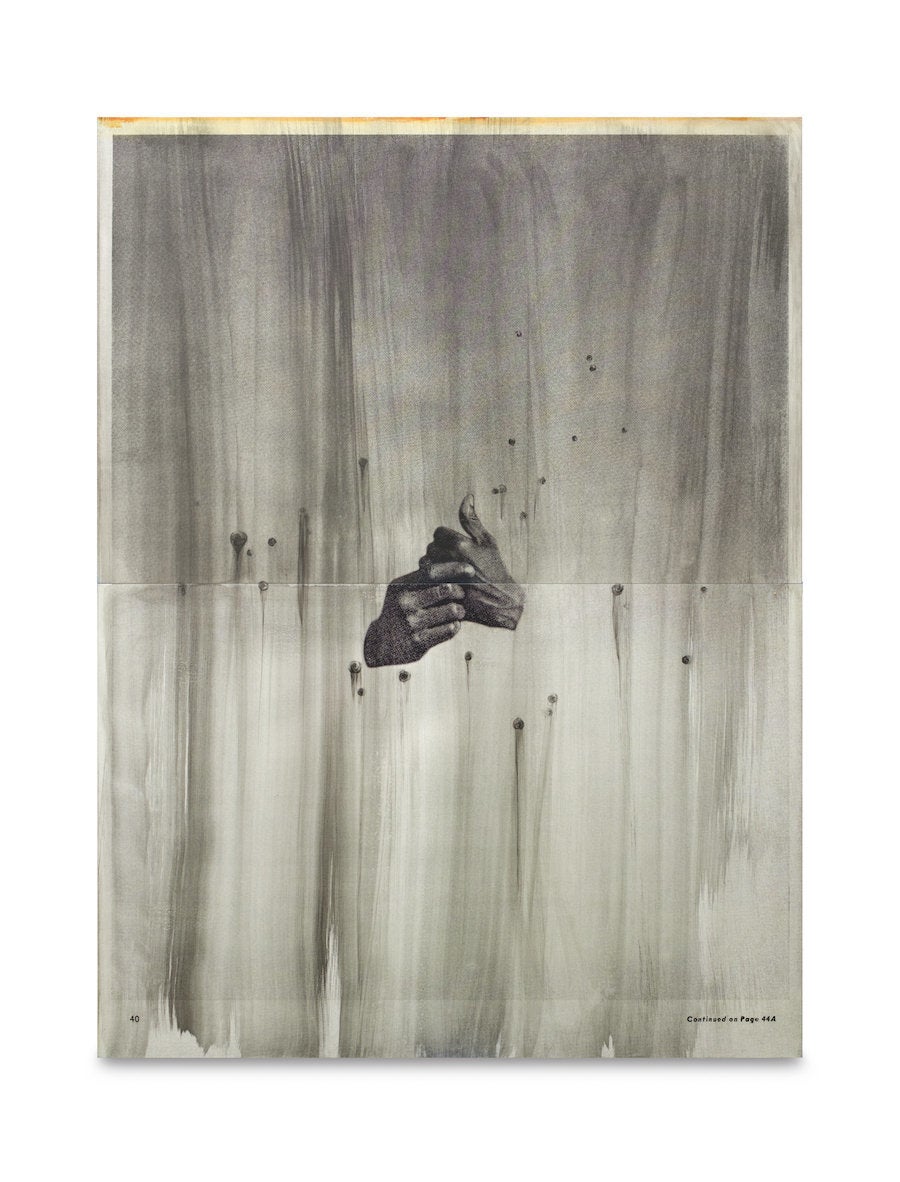
This interview has been edited and condensed for clarity.
